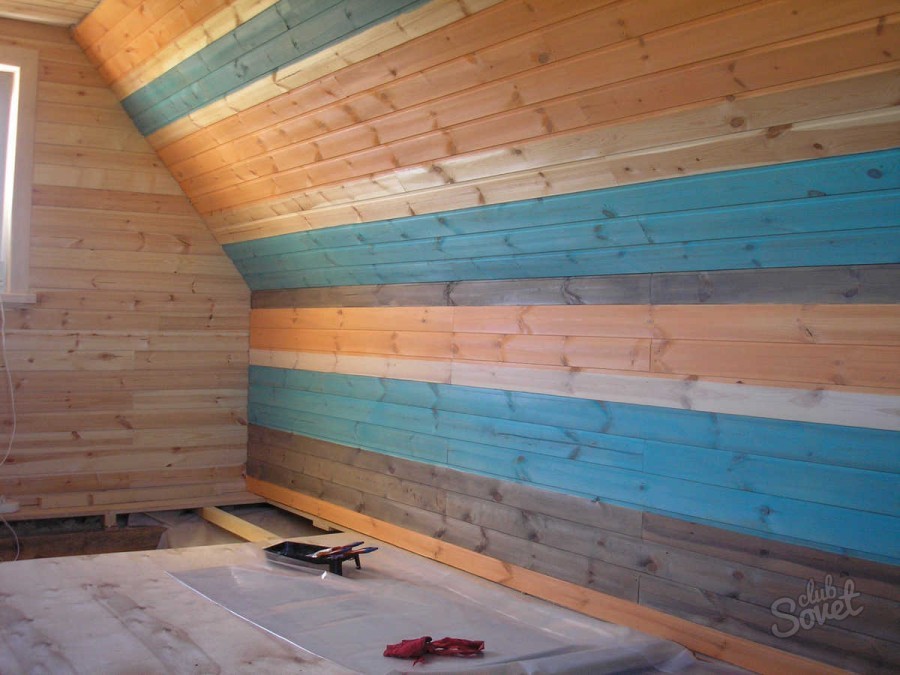To extend the life of the lining and improve aesthetic appearance, it is recommended to be covered with a special composition. Otherwise, the material will darken. In addition, the mold is successfully started, the fungus grows and the provoking rotation of microorganisms live. Therefore, it is so important to know how to paint the lining.
There are many means suitable for covering lining, there is a great set that sometimes you can even get confused in all the variety, but they all are divided into those aimed at protecting the material, and those recognized to emphasize its appearance. Protective Forms:- Antipirens. These substances are able to reduce the flammability of the material, which is relevant for wooden lining. However, remember that the application of the substance is less efficient than industrial pressure processing.
- Bactericidal compositions. Used to prevent rotting rotting due to the reproduction of bacteria and the development of fungus. If you take work within the house, then look for an appropriate note on a can with a substance - "for internal works."
- Acrylic varnishes. They are used to complete the procedure for processing the clapboard. The compositions not only protect the material, but also perform a decorative function. Severe transparent varnishes, which are applied as the first layer, and compositions with the addition of the caloring mixture.
- Synthetic varnishes. These substances are toxic than acrylic, but they give the lining a smoother surface, and its glitter becomes rich. However, most of the substances are used exclusively in external work, since there is xylene and toluene in their composition.
- Composition based on wax. They give the wood material an unusual half-arctic brilliance, but quite complex in applying.
- Covered antiseptics. Buy this composition if your goal is to protect the product from harmful microorganisms and high humidity. It will also help in the fight against the destructive effect of ultraviolet radiation. Capable to penetrate well into the material. However, when they are used, wood texture is not visible, since such an antiseptic is opaque.
- Lesseing antiseptic. Thanks to the properties of the composition, the color shade of the lining is well emphasized. At the same time, protection against mold and atmospheric precipitation is provided. But remember that such substances can not be applied before carrying out a subsequent painting, they are not intended for this, as well as to apply to the old paint.
- Alkyd varnishes. Their largest drawback is that the lining does not breathe under their layer, since the composition is quite dense.
- Yacht varnish. The substance is considered to be resistant to sharp jumps of the temperature regime and a humid environment. In addition, it prevents the yellowing of the material.
- Oil paint. Resistant to moisture, well penetrates inside the material. But it is not devoid of flaws: dries slowly, capable of fading over time. This composition is recommended only to cover individual elements, since the lining does not breathe under it.
- Acrylate paints. Their properties are an order of magnitude higher than in oil paint. Covered with this composition lining the longer saves color. The substance is not capable of cracking with sharp temperatures, as it is quite elastic. But high-quality acrylate paint is expensive.
- Acrylic aqualaks. Aqualak heard the best tool that exists to cover the lining inside the house. It is non-toxic, and therefore completely safe substance without heavy metals.
- Outside the house is usually used with lining made of coniferous rocks, as their resin has good protective properties from fungus. However, this does not mean that such material does not need to handle anything. The surface is first ground, and then apply acrylate or oil paint, lesing antiseptic, pearl paint-glaze or varnish.
- Inside the house you can use cladding of conifers, as well as hardwood. In this case, it is not worth covering the material with a caloring mixture, which will score its texture. The best choice will be aqualak, because this composition is able to emphasize the sophistication of the natural tree. Euromagles paint acrylate varnish.
- Balconies and loggias often sheathe clapboard, to improve the appearance of the premises. That is why the coating material or alkyd varnish akvalakom.
- Typically, when finishing closed veranda used Lining. In this case, it should paint lacquers, made on urethane alkyd. You can also apply Yachting varnishes, since they do not react to temperature fluctuations.
- Terrace is an open platform with or without a roof. The ceilings are covered with clapboard sheathing structures adopted. The same applies to the supporting pillars. For the open space, select the same composition as that of painting the outside of the building.
- Chatter is similar to the terrace, however, proceed as described in paragraphs 1 and 5.
- Very popular lining for finishing baths and saunas. Preference is given to materials made from basswood, aspen, alder. In this case, battens should cover the special oil having a natural basis. In this case, the body will have no harmful effects.
Thus, there are many options to treat than bunk. To help you use our article, but also be sure to carefully read the instructions from the manufacturer applied to the composition. After all, there you will find information on the environment, the use of specific substances.



































